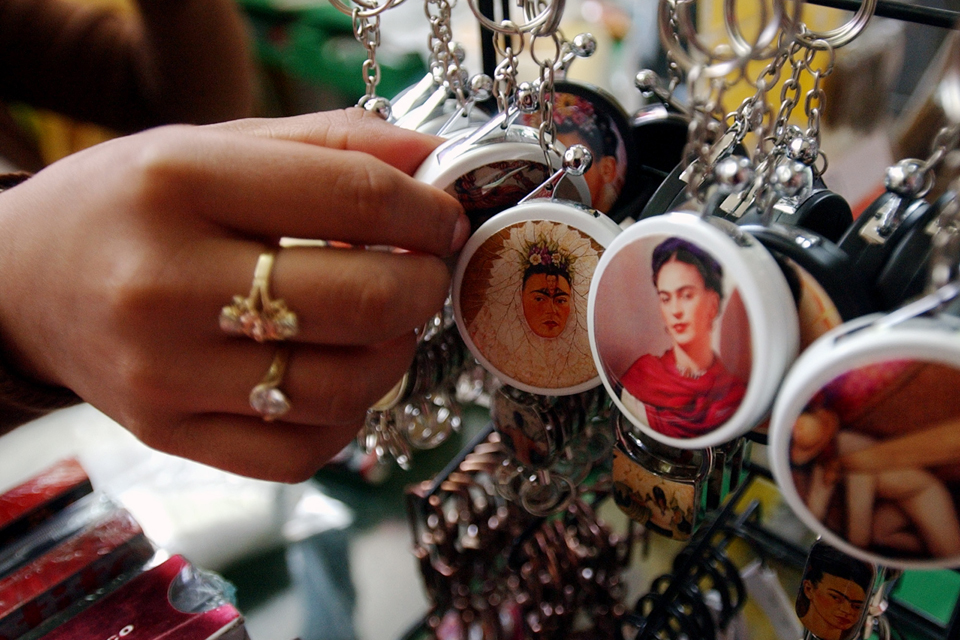
MEXICO CITY—“No veo Mexicanos con Frida Kahlo mierda.” (I don’t see Mexicans with Frida Kahlo shit.) Andrey, one of the owners of a street food tour who meets visitors to his city from all over the world, told me this standing in the Plaza De La República. He was responding to my question of how the Mexican people feel about the globalization of Frida Kahlo’s image, story, and symbolism.
If he’s right, you wouldn’t know this from a quick visit to any of Mexico City’s multitude of open-air markets. The face of Frida Kahlo appears for sale everywhere in this city of nine million people. A walk through a single market, La Merced, for example, shows you Kahlo appearing as photograph, freestyle drawing, and even in manga and anime style on a vast array of t-shirts, bracelets, key fobs, shot glasses, hats, bandannas, tote bags, coffee mugs, mezcal cups, and indeed any commodity one could conceivably imprint her face on.

Indeed, one of the peculiar things about the commodification of Kahlo’s image is that the omnipresence of her face supersedes representations of her art. For a few pesos, I could have purchased a pair of socks with her image on them. It’s much more difficult to locate, even in Mexico City, postcards that feature her actual work. Yet, if you spend 500 pesos on her image, she’ll stare back at you from the bill itself.
The tourists who line up around the block to get into Casa Azul, the Frida Kahlo House and Museum in the now upscale Coyoacan neighborhood, often appear on pilgrimage. I lined up with them to see the famous residence where she lived with Rivera and hosted the likes of André Breton, Sergei Eisenstein, and, most famously, a fugitive Leon Trotsky and his wife and collaborator, Natalya Sedova.
There may be no busier museum of comparable size in the city, and it even competes with some of the larger historical sites (I certainly saw more people at the Kahlo House than at The Museum of Interventions). Kahlo’s art can be seen here, framed on the cool plaster walls. You can see the studio space she shared with her famous husband, Diego Rivera. Every month, an estimated 25,000 visitors take the slow walk through its ten rooms and gardens rich with Rivera’s collection of Mesoamerican art.
Unfortunately, one finds in the gift shop more expensive, and higher-end, versions of what one sees throughout Mexico City and across the internet: images of her face on chachkas of all kinds. Even books about her life, her art, and her politics are scarce. In fact, absence of politics and political discussion around Kahlo may be the most disconcerting aspect of the fascination with her.
A political legacy ignored
One American woman in line to see the Kahlo Museum described her as “the embodiment of what a woman can do, she’s all about artistic expression.” Andrey, my street food guide, told me that she had become a “symbol of feminism,” an idea he dismissed rather too casually.

A search around the internet does seem to suggest that the oversaturation of Kahlo’s image and a much-revised version of her life story has led to her becoming a symbol of a very amorphous notion of self-realization connected to art. However, a hint of misogyny can easily sneak into such a critique.
This is a failure to think politically on par with the new age-y fascination with Kahlo. There’s much more to the commodification of Frida Kahlo than some kind of apolitical girl power sensationalism. Indeed, one American woman, a self-confessed fan of Kahlo and her work, spoke rather angrily of the rich political and social debates hidden from tourists at Casa Azul. “Everyone who comes here should have to take a quiz first,” she concluded.
The presentation of Kahlo’s work at the museum certainly explains her frustration. For example, one of her lesser known paintings, Marxism will give Health to the Sick, is described by the accompanying museum panel as representative of her struggle to overcome her physical disabilities. Marx quite literally hovers above her in the sky, a symbol of class struggle having greater significance than personal ills. The description chooses to leave this unmentioned.
Beside this picture hangs her infamous painting of Stalin that foregrounds an image of herself looking on adoringly. This representation of Kahlo and Rivera’s still controversial decision to embrace Stalinism after Trotsky’s murder receives no interpretation at all.
Two of the most popular rooms in the museum are Kahlo’s private bedrooms. Here are portraits, almost icons, of Communist leaders, including Marx, Engels, Lenin, and Mao Zedong. An enormous frame hanging in her bedroom holds the well-known May 5, 1920, photograph of Lenin speaking to Red Army troops with Kamenev and Trotsky on his left. No commentary explains the importance of these images; the last thing Kahlo would see each night and the first each morning.

How we failed Frida Kahlo
What could be wrong with displaying the face of one of the great surrealist painters of the twentieth century on almost anything? Moreover, why should the Museum of Frida Kahlo, that has done so much to bring attention to her life and work, be criticized for not loading down eager visitors with political history?
In fact, it’s the Left that has failed. What Marx called “commodity fetishism” and what Walter Benjamin worried over as “the fate of art in the age of mechanical reproduction” is not news. Neither does a bland criticism of “consumerism” get us anywhere. Indeed, it doesn’t even get us beyond the mild liberal disdain for the uninformed.
Marx wrote in The German Ideology, as most leftists know, that in any era the ruling class creates the ruling ideas. It’s not faceless consumers or “eat, pray, love” tourists who have failed Frida Kahlo. Socialist thinkers, writers, and educators have failed her legacy, and that of hundreds of figures key to our history. We have failed.

Dialectical criticism and debate carries forward the political education of the workers. To understand and, most importantly, explain Kahlo, we must debate the meaning of Mexico’s revolutionary past and increasingly neoliberal present. We must confront the ghost of Stalinism again, perhaps to our embarrassment. Marx meant it when he spoke of “ruthless criticism” of “all existing conditions.” Throwing up our hands at ideology in public history or ill-informed Frida Kahlo admirers is nothing but bloated self-actualization, precisely the kind of behavior it’s tempting to accuse the Kahlo cult of engaging in.
During my time in Mexico City, I visited the Trotsky house just down the street on Avenido Vienna, where one does learn a great deal about socialist politics and history. I also purchased a Trotsky t-shirt, cap, and two bookmarks. Dialectical criticism must always lead to self-criticism in any socialist thinking worthy of the name. This can then help us to speak thoughtfully to workers who want to know more about the hidden history of struggle—a history that includes, in all her complexity, Comrade Kahlo.










